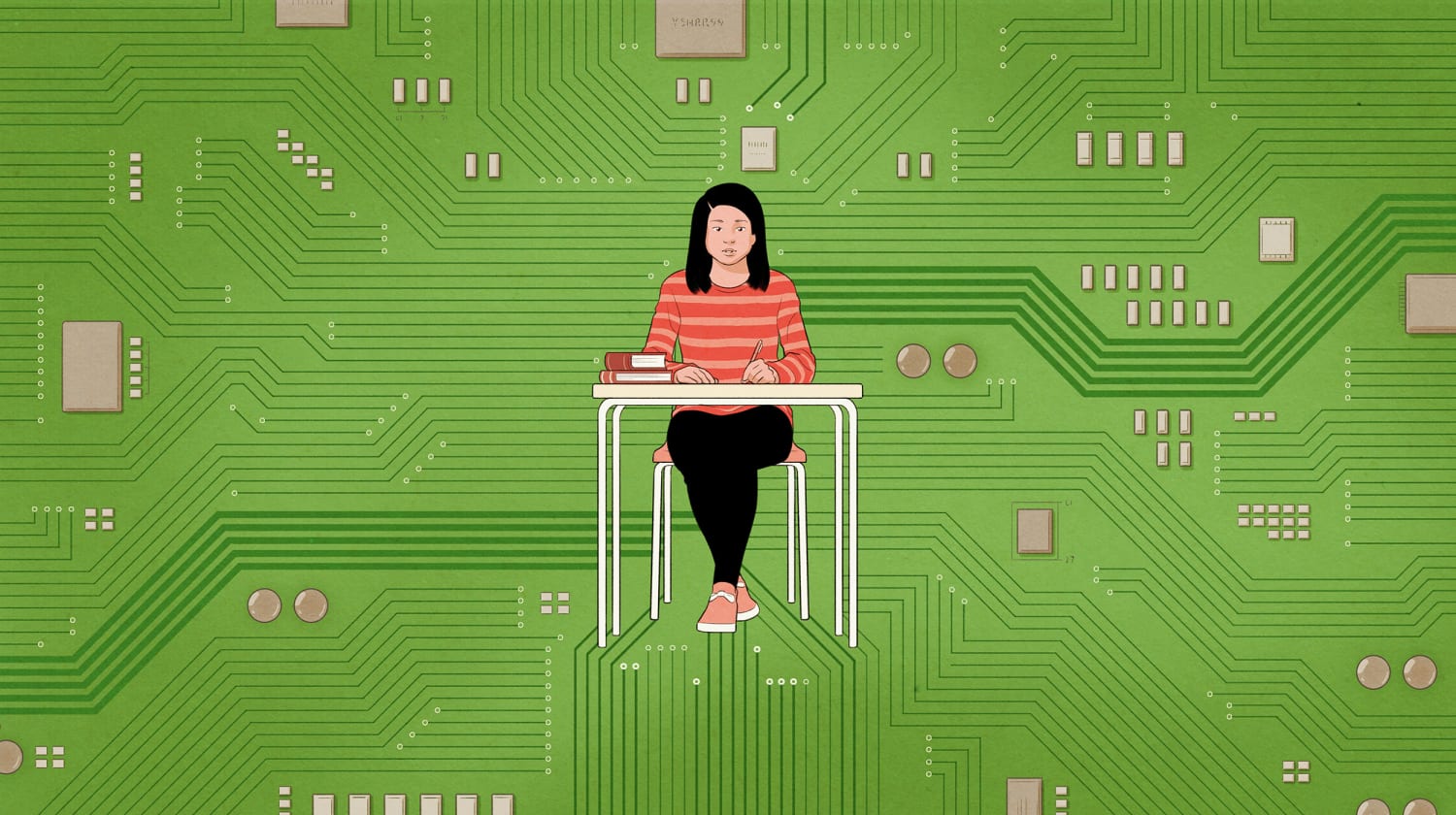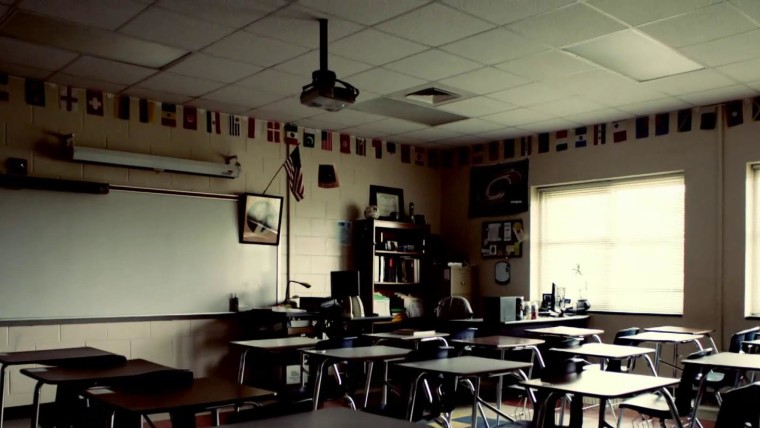When Nevada high schooler Simone Gardella scored a zero on a short writing assignment early last fall, she thought the grade was inaccurate. But she couldn’t find out what she might have done wrong. No human teacher had read what she wrote, and the computer program that had given her such a low mark didn’t provide any feedback.
“A robot is my teacher,” said Gardella, a senior who had taken Advanced Placement classes before the coronavirus pandemic arrived. “I put thought into it. I felt like I answered the question. But I didn’t get to find out what I did wrong.”
She saw more problems with the online lessons, and eventually, she spoke up, writing a letter to her local newspaper to criticize school administrators and Edgenuity, the vendor that her district had hired for remote learning.
It turned out that there were a lot of critics of Edgenuity, an education tech company based in Scottsdale, Arizona, and owned by private investors. Edgenuity sells an online curriculum for grades K-12, and before the pandemic, it was known in large part for “credit recovery”: online classes for students who had previously failed courses or otherwise needed to catch up.
Then the pandemic hit, leaving school districts to figure out how to suddenly educate entire schools over the internet. And Edgenuity has bore the brunt of a lot of the frustration in recent months.
The company has been the target of picketing, anger-filled school board meetings and local freedom-of-information requests from parents and students who say its software is inadequate for taking classes at home. Parents have turned to Edgenuity’s Facebook page to lodge complaints, and petitions have popped up on Change.org to ban Edgenuity’s software. In Rhode Island, a teachers’ union alleged that administrators were using Edgenuity to replace them.
Interviews with eight parents in five states showed how Edgenuity software was pressed into duty by some school districts as a kind of all-in-one approach to remote learning after Covid-19 shuttered most schools nationwide 11 months ago.
It’s one piece of a nationwide struggle to move learning online in response to the pandemic, a herculean task that has meant turning living rooms into classrooms, finding laptops for families who didn’t have them and learning how to remember login credentials for countless websites.
Edgenuity (pronounced like “ingenuity”) says its software is used by more than 20,000 schools nationwide, including in 20 of the 25 largest school districts. It says 4 million students and teachers had accounts on its products last year.
The company, founded in 1998, said that its products weren’t designed for a pandemic and that it’s up to schools to provide live teachers. Deborah Rayow, Edgenuity’s vice president for instructional design and learning science, said in an interview that some school districts were having more success with the company’s tools than others. The most successful ones, she said, have blended its software with live teacher interactions of some kind.
“The schools that are using Edgenuity with more teacher involvement, that have provided more training for their teachers, are likely finding more success,” Rayow said.
She said Edgenuity welcomes the suggestions from students such as Gardella and from parents who have also given feedback. “We have very bright young people in this country, and some of them have great ideas for how to make education better,” Rayow said.
That has provided little solace for students and parents who said their families have slogged through hours of solitary online material, sometimes with little to show for it.
Gardella said things have turned out all right for her. The zero on the short assignment accounted for only a small part of her grade, and she has been accepted to the college of her choice. But even in her case, her transcript from the early fall had much lower grades than she was used to, and she said she has missed having human teachers.
“In normal school, in English, you’d be learning over time what specific things your teacher looks for, what specific things your AP graders will be looking for,” Gardella said. “Your grade might go from 80 percent to 100 percent, but I was never actually able to experience that growth.”
An imperfect situation
The backlash has been especially strong in communities where school officials rely on Edgenuity software to teach students without any live video with local teachers or classmates to supplement it — that is, no video conferencing with a class via Zoom, Google or Microsoft, but only recorded lessons from Edgenuity, accessed alone.
“It was basically him watching videos for eight hours a day,” said Jen A., a parent in the Reno, Nevada, area whose child has been using the software. She asked that her last name not be used because of possible consequences of criticizing the education system.
“It was video after video after video,” she said. “It would give you instructions on the videos. But there’s nothing like having a live teacher along the way.”
In her school district and some others, families were given a choice last summer: one track that had in-classroom teaching, along with a potentially higher Covid-19 risk, or an entirely at-home option based on Edgenuity. Her family chose the latter, without really knowing what they were getting into, she said.
“Edgenuity was not designed for a pandemic,” she said. “It was designed for children who were on vacation or were maybe sick for an extended period of time and had to do schoolwork from home.”
“I feel like once the pandemic hit, it was, ‘OK, let’s use this,'” she said.
In Jen A.’s school district, in Washoe County, administrators signed up with Edgenuity for a limited credit-recovery program in 2019. Now, about a third of the student population is full-time on the service, said Stacey Cooper, the extended studies coordinator for the district.
“When we hit the pandemic, we quickly realized we were going to need to use Edgenuity more than we originally bargained for,” she said.
Cooper said that, in hindsight, the district rolled out Edgenuity the wrong way, putting too big a workload on students in the fall and not having the time to train teachers in a “blended” style that includes more interaction. The district allowed students to redo some work over the winter break, and it made other changes after the fall semester in response to feedback from parents and students, including encouraging teachers to provide more virtual live support via Microsoft Teams software, she said.
“It overwhelmed them,” she said of Edgenuity’s impact on students. “But we didn’t know. We didn’t know what we didn’t know as a school district.”
Edgenuity markets its courses as engaging, and Rayow said it has provided school districts with training kits and online information sessions to help teachers who are new to remote schooling. The results, however, have been uneven, she said.
“This is not a perfect situation to implement any new tool,” she said.
School districts in general have been harried figuring out new software over the past year.
“We are doing a lot of building the plane as we’re flying it,” said Corinne Hyde, an associate professor of clinical education at the University of Southern California.
“A lot of things are being used beyond their intended purpose, and they’re serving as stopgap measures,” Hyde said. “They’re better than nothing, but that doesn’t mean they’re as good as they would be if someone had knowledge beforehand.”
‘You’re not dealing with widgets here’
For many parents and students, the pandemic has been a chance to get their first up-close look at the burgeoning corner of the tech industry known as ed tech, and many of them have said they don’t like what they see: from the automated grading of some assignments to the profitsof companies selling their services.
“If you’re a for-profit company, you’re always looking at the bottom line,” said Colleen Egleston of Middleville, Michigan, whose seventh-grade son uses Edgenuity. She said her son has a video call with a local teacher four days a week for an hour at a time. But otherwise, she said, he has to be glued to Edgenuity’s software, with only his parents to help — which not all students have.
“You’re not dealing with widgets here. You’re dealing with kids,” she said. “You have to spend the money for our next generation and not use them as a profit center.”
Edgenuity, like many other education technology companies, is privately held. Its owner, Weld North Education, is a private equity firm, and the firm’s investors include other private equity firms, such as Silver Lake and Onex.
Rayow defended the company’s for-profit status, saying its employees are passionate about education. Most employees, including her, have experience as teachers or administrators, she said. Edgenuity’s CEO, Sari Factor, taught mathematics before she spent most of her career in business at companies like Kaplan and McGraw Hill.
“Private companies’ being involved in education is not new. Textbook companies have been around for a long time,” Rayow said.
But parents said there are differences that make Edgenuity seem like a black box. They complained that they can’t see into its grading algorithms or much else.
Amy Herczeg, a social worker in Allentown, Pennsylvania, said that when her ninth-grade daughter got an unusually low grade on an exam in the fall, she wanted to see it.
“I’m used to her bringing home her tests,” she said.
But it wasn’t that simple. The test was online, and the school didn’t have a copy to provide. Herczeg contacted Edgenuity, but it wouldn’t give her a copy.
“They said they don’t provide that,” Herczeg said. And it wasn’t the only time she has been frustrated by the lack of information about what her daughter is studying.
“There’s no textbook, and there are no worksheets, and there’s no curriculum. So I can’t page through and see the curriculum,” she said. To see what her daughter is studying, Herczeg needs to log in using her daughter’s credentials, but she said that can create a new problem: Edgenuity records that time as her daughter’s being “idle,” a metric that might not affect her grade but that a school might use to measure perceived productivity.
She said that the setup makes it difficult to be an involved parent and that students are being hurt by the lack of personalized attention.
“There’s more of an urgency to click through a curriculum than actually absorb it and understand it,” she said.
Rayow, the Edgenuity executive, said the company limits the sharing of exams to prevent cheating. “We struggle with that one, because certainly there’s a great educational reason for letting parents see those exams,” she said. But she said cheating concerns were overriding for now.
She also said that automatic grading by computer algorithm accounted for only a small part of students’ grades, around 5 percent, and that automatic grading was done only for minor work called “journal assignments.” For major exams, “the grade that students see is a grade chosen by the teacher, always,” Rayow said.
Rayow also said that, as far as Edgenuity is concerned, there’s no penalty for excessive “idle” time by a student.
Parents take action
Cheri Bruinsma, a lawyer with two kids learning from home on Edgenuity, was so dissatisfied with Edgenuity and what she saw as the lack of transparency that she filed a request under the Michigan Freedom of Information Act to get a copy of her school district’s purchase orders. They showed that the district was paying Edgenuity tens of thousands of dollars for the year, an amount she found surprisingly low.
“It seemed like it was a fairly inexpensive solution for what had to be done,” she said. The school district, she said, seemed to have “jumped on Edgenuity as an easy solution without a lot of investigation.” Her school district declined to comment.
Bruinsma has since moved her daughter to another district that does not use Edgenuity, but she said it was previously common for her daughter to put in nine to 10 hours a day, six days a week, to keep up with the Edgenuity workload. She could reach out to a teacher for help, but the teachers were busy with students who had chosen to resume in-person instruction — a choice not all parents made, given the risks of Covid-19.
And even if teachers had time to respond, they weren’t necessarily familiar with Edgenuity’s curriculum, because it’s different from what’s taught in person, Bruinsma said.
The sometimes-robotic nature of online learning was criticized even before the pandemic. Some teachers said Edgenuity’s credit-recovery classes were too easy to game, because students could retake tests they had failed and see many of the same questions a second time, Slate reported in 2017. Edgenuity disputed the criticism, telling the site at the time that it would be “highly unusual” for students to see very many duplicate questions.
And in the fall, some students claimed to have found another way to artificially boost their Edgenuity grades by gaming the algorithms: When an assignment called for a written answer to an open-ended question, they would simply insert a jumble of keywords — a “word salad” — at the end of a written answer. Rayow said those assignments account for a very small percentage of grades.
Some parents said they were making arrangements to switch schools, either to charter schools or to other districts, to get away from Edgenuity.
“The program has problems. We should acknowledge that and move forward,” said Egleston, who said she’s moving her son to a regional district that doesn’t use Edgenuity.
Rayow, of Edgenuity, said the company is focused on making sure teachers and administrators are trained in how best to use their software.
“We ourselves don’t have a lot of direct lines of communication with parents,” she said. She said that purchases are made through the schools and that Edgenuity doesn’t always have a lot of information about children or their parents.
Parents and experts said they fear what students are missing by going a year with much less human contact.
“There are some kids for whom Edgenuity would probably be fine, but that’s not going to be a good solution for your entire education program because of the importance of interaction,” said H. Alix Gallagher, the director of strategic partnerships at Policy Analysis for California Education, a research center for five California universities.
Gallagher said self-directed software or even live video lectures can’t replace the back-and-forth that comes in classroom discussions or small groups.
“What research shows about high-quality instruction for kids is that it has to be engaging and interactive,” Gallagher said. “If there isn’t interaction, it’s not working well, and teachers haven’t been supported. It’s a system problem.”
Source: | This article originally belongs to Nbcnews.com











